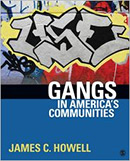Gangs in America’s Communities

Author: James C. Howell
Thousand Oaks, CA: Sage Publications, 2012. 347p.
Reviewer: Eric G. Lesneskie | September 2012
Street gangs are researched extensively, with literally thousands of gang studies having been completed, and the interest in gangs will remain strong for years to come. With all of this attention, there are more undergraduate courses being offered focusing exclusively on street gangs. Yet, surprisingly, there are relatively few options when choosing a text for such a course. James C. Howell helps to address this need with his book Gangs in America’s Communities (2012). This text provides an up-to-date review of research and covers the major topics that are often in the forefront of classroom discussions, including the history and theoretical explanations of gang formation, female gang involvement, gang violence, and the extent of the gang problem in the United States. Where this text stands out, however, is in its coverage of two important topics: 1) the myths associated with street gangs; and 2) the review of the prevention and intervention strategies that are used to control gang activity.
Howell outlines 22 myths that are often associated with street gangs. For example, a myth that is popular among the public, including students, is that gang membership lasts for life. In reality, as Howell demonstrates, gang membership is typically short-term, often less than one year. By presenting the empirical evidence that debunks these myths, the author provides readers with a clearer understanding of street gangs. Secondly, many prevention and intervention programs have produced inconsistent results, which contributes to the myth that “nothing works” when dealing with gangs. But, according to Howell, there are some programs that have produced reductions in gang activity in the areas where implemented. Howell starts his review of “what works” in preventing and reducing gang activities by advocating the use of a comprehensive model; this is one that utilizes a community wide organizational structure. In identifying the steps and methods that are used to implement this type of program, Howell provides the reader with an understanding of what must be undertaken in order to effectively reduce gang activity. An effective comprehensive gang model incorporates community mobilization, providing opportunities to gang involved youths, social interventions, suppression, and organizational change and development to address the gang problem in a community.
Although Howell covers most of the major topics associated with gangs, there are some areas that could have been expanded upon. For instance, there are many different types of gangs in the U.S., and often these gangs are identified based on their ethnicity or race. These differences are acknowledged by Howell, but the specific differences between these gangs, such as their activities and subcultures, are not covered.
Both students and academics will benefit from this text. This review of gang research is written clearly and concisely, with the intended audience obviously being students. Furthermore, at the end of each chapter, Howell includes discussion exercises and recommendations for further reading. These exercises and recommendations provide students with opportunities to expand upon the ideas presented in the chapter and, if desired, to further explore the issues at hand. But this book will also be beneficial to academic researchers, because it provides a starting point for entering the expansive and expanding realm of gang research. In sum, Howell’s Gangs in America’s Communities covers some of the most important and pertinent topics associated with gangs today, thus fulfilling the needs of both students and the larger academic community.
Eric G. Lesneskie is a Ph.D. candidate at the School of Criminal Justice, Rutgers University- Newark.


